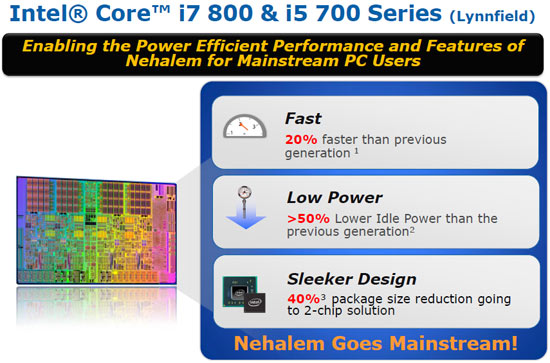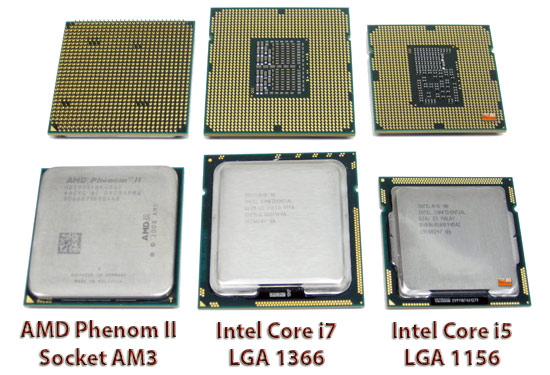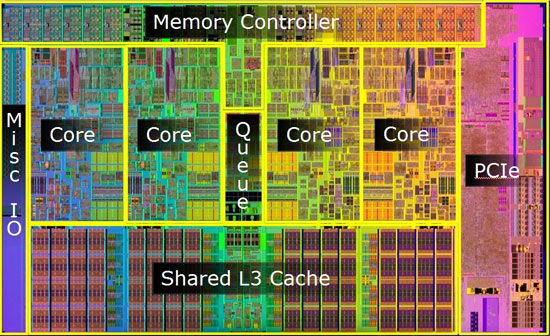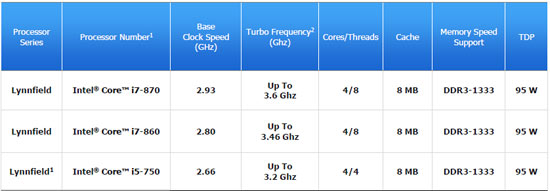Intel Launches Two New CPU Series and a Chipset
On August 11, 2008, Intel announced the Core Processor Family with the first desktop versions of the new Nehalem-based processor family are branded the Intel Core i7 series. These processors have dominated the market when it comes to performance, but they also come at a higher price premium. Today, Intel is unleashing Core i5 and i7 8XX series processors, and the accompanying P55 Express chipset that supports these 'Lynnfield' processors to the market. These processors are largely based around the Nehalem architecture that launched in November of 2008, so many of the key technology features remain the same. 
The changes in Lynnfield are significant, though, as they need a new socket, CPU coolers and the P55 chipset. This is due to the fact that Intel has changed the integrated memory controller back to dual-channel, brought the PCI Express connectivity onto the processor, and improved their Turbo Mode functionality to offer varying levels of increased performance depending on the type of application being used. The end result is a processor that is smaller with a more budget-friendly single-chipset motherboard to go along with it. The performance hit by losing features like triple-channel memory is present, but unless you plan on running Super PI for work, the cost savings should be substantial and worth it.

To give you an idea of the new Lynnfield processor the above picture shows an AMD Phenom II 965 BE processor on the left with an Intel 'Nehalem' Core i7 975 processor in the middle and the Intel 'Lynnfield' Core i5 750 on the right. As you can see, the new LGA 1156 socket is actually smaller than even the AMD Phenom II's socket AM3 processor. It happens to be comparable to Intel Core 2 LGA 775 socket if you recall the size of one of those processors.

Pictured above is the Lynnfield die that shows all 774 million transistors in the 296 mm2 package that is manufactured on Intel's 45nm high-k fab process. The new Core i7 and i5 processors are the first Intel processors to integrate both a 16-lane PCI Express 2.0 graphics port and two-channel memory controller, enabling all input/output and manageability functions to be handled by the single-chip Intel P55 Express Chipset. Previous Intel chipsets required two separate chips. A new Direct Media Interface (DMI) connects between the processor and chipset. So what is the difference between a Lynnfield Core i5 and Core i7 processor?
Intel Core i7-800 processor series:
- Intel Hyper-Threading Technology delivers 8-threaded performance on 4 cores
- Intel Turbo Boost Technology
- 8M Intel Smart Cache
- Integrated Memory Controller with support for 2 channels of DDR3 1333 memory
- PCI Express 2.0 discrete graphics flexibility for multiple graphics card
Intel Core i5-700 processor series:
- Intel Turbo Boost Technology
- 8M Intel Smart Cache
- Integrated Memory Controller with support for 2 channels of DDR3 1333 memory
- PCI Express 2.0 discrete graphics flexibility for multiple graphics card
Basically, any Lynnfield processor that has HyperThreading technology is a Core i7 part and those without HyperThreading are Core i5 or Core i3 processors.

Today, Intel is releasing two Core i7 processors: the Core i7-870 and the i7-860. Since these are part of the Core i7 800 family they are quad-core processors with HyperThreading enabled (support of 8 threads). They are also releasing the Core i5-750, which is a quad-core part without HyperThreading. All of the Lynnfield processors have the same 8MB L3 cache as the Core i7 offerings. As you can see from the chart above, the base clock speed of the Core i7-870 is 2.93GHz, but the Turbo frequency is nearly 700MHz higher at up to 3.6GHz. Under certain loads the processors will have the ability to scale up to some pretty high frequency, which is how it does so well against current Core i7-900 series processors. Let's take a closer look at CPU-Z and Intel Turbo Boost technology.







